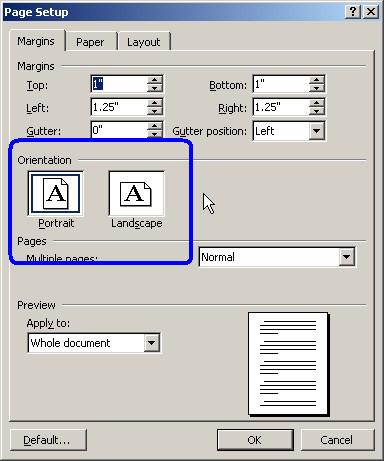How To Make The Microsoft Word Page Horizontal
Best Answer: On the Microsoft Word menu bar: Click 'File' >Click 'Page Setup.' This will open up the 'Page Setup' dialog box. There are three tabs.

You may already know how to align text on the left center or right part of the page in Microsoft Word. But what if you wanted to use more than one type of alignment on the same line? For example, in college many of us had to write paper and label it with our name, the date, and the class name. One way is to type everything and play around with inserting extra spaces until it all 'looks good.'
But this is an inefficient and imprecise process. Let's take a look at how to do this simply and make our documents look polished using 'tab stops.' When you are typing in Word and press the 'tab' button, you will usually see a noticeable amount of space inserted before the next thing you type. By default, the program sets alignment markers every 0.5' horizontally. Between each of the words above, a 'tab' was entered instead of a 'space.' Notice how in each case, the line moved horizontally to the next 0.5' mark ('is' at 0.5', 'an' at 1.0', etc.).
You can manually set tab stops to control the horizontal alignment of your text. Waldorf Wave Table. At the upper left of your document, next to the ruler, you should see this icon: By using that button and the ruler, you can automatically create tab stops wherever you like.
First you need to be be familiar with the different tab stop symbols: Symbol Tab Stop Type Left - Aligns all text with the leftmost part located at the tab stop. Center - Aligns text so that the horizontal center of the text is even with the tab stop. Right - Aligns all text with the rightmost part located at the tab stop. Decimal - Aligns numbers to be centered at the decimal point. Here they all are in action: Likely you can see many practical applications of the different alignment types.
So, how can you use these yourself? By clicking on the icon on the upper left of the document repeatedly. You can change the button to display each of the four types of tab stops as well as some other characters that are not relevant to this discussion. When the button shows the type of tab stop that you would like to insert, simply click in the ruler at the desired horizontal location. For example, consider a standard 8.5' x 11' document with 1' margins on all four sides in which you would like to center some text. Taking off 2' for your left and right margin, the width of your page is 6.5'.
The halfway mark, then, would be at 3.25'. • Click the button until it shows the Center Tab Stop symbol. • Click in the ruler at 3.25'.
• Type whatever you'd like and admire the formatting!

It's easy to change the orientation of an entire Word document but not so simple when you only want to change the orientation of a single page or a few pages in the document. As it turns out, you can insert a landscape-oriented page, which is a horizontal page layout, into a document that uses portrait orientation, a vertical page layout, or vice versa. You may have a wide table that you need to use in a report or a picture that looks better in landscape orientation. In Microsoft Word, you can either insert section breaks manually at the top and the bottom of the page that you want in the other orientation, or you can select text and allow Microsoft Word to insert the for you.
FatCamera / Getty Images To tell Microsoft Word where to break the page instead of letting Word decide, insert a Next Page Section Break at the start and end of the text, table, picture, or other object for which you are changing the page orientation. Insert a section break at the beginning of the area that you want to rotate: • Select the Page Layout tab. • Click the Breaks drop-down menu in the Page Setup section.